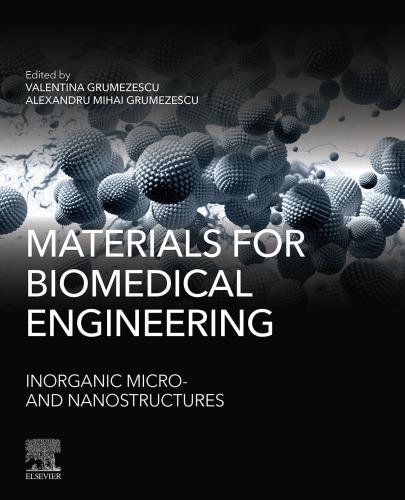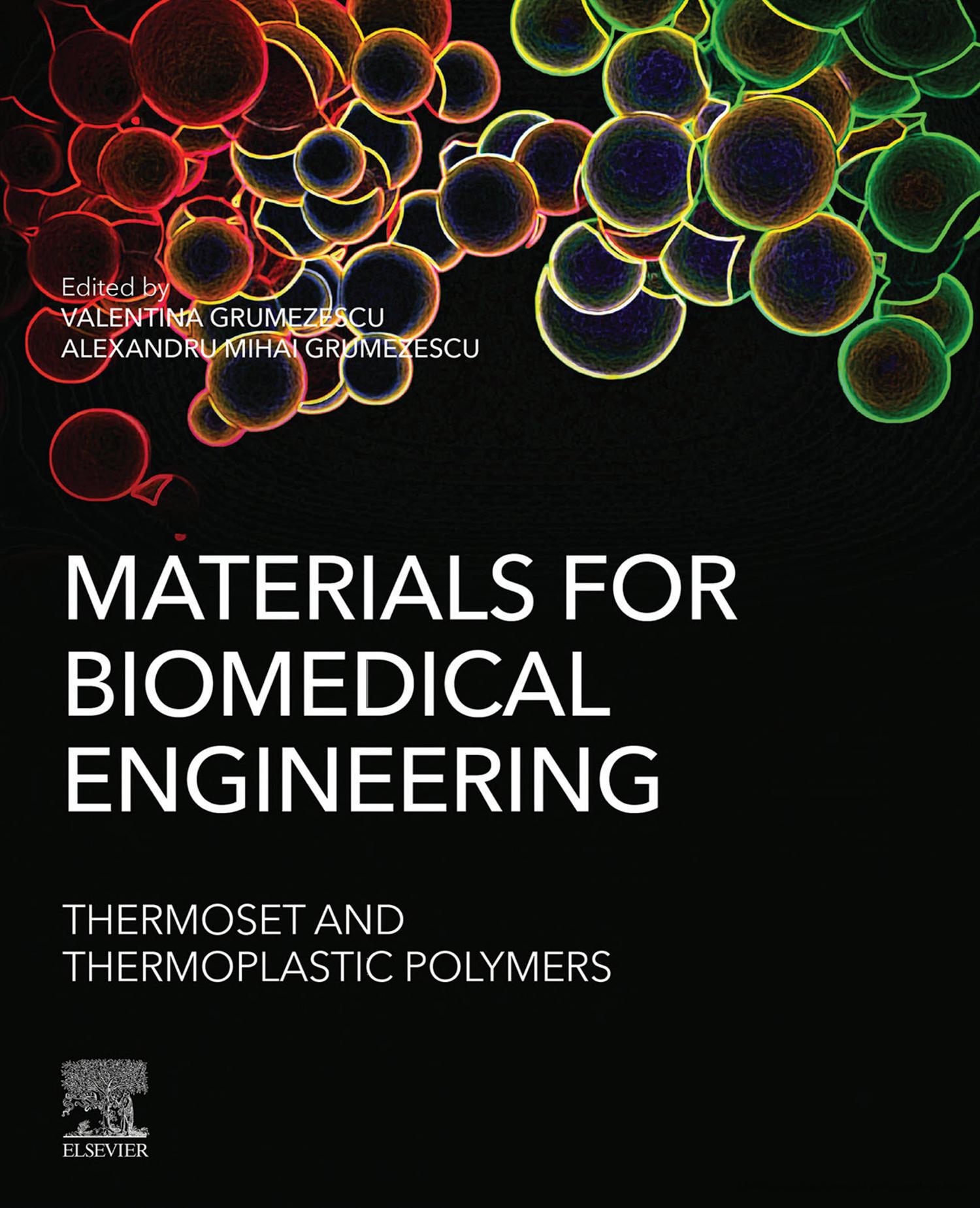https://ebookmass.com/product/materials-for-biomedical-
Instant digital products (PDF, ePub, MOBI) ready for you
Download now and discover formats that fit your needs...
Materials for Biomedical Engineering: Inorganic Micro- and Nanostructures Valentina Grumezescu
https://ebookmass.com/product/materials-for-biomedical-engineeringinorganic-micro-and-nanostructures-valentina-grumezescu/
ebookmass.com
Materials for Biomedical Engineering - Inorganic Microand Nanostructures Valentina Grumezescu
https://ebookmass.com/product/materials-for-biomedical-engineeringinorganic-micro-and-nanostructures-valentina-grumezescu-2/
ebookmass.com
Materials for Biomedical Engineering: Hydrogels and Polymer-Based Scaffolds Alexandru Grumezescu
https://ebookmass.com/product/materials-for-biomedical-engineeringhydrogels-and-polymer-based-scaffolds-alexandru-grumezescu/
ebookmass.com
The Rise of Neoliberal Feminism Catherine Rottenberg
https://ebookmass.com/product/the-rise-of-neoliberal-feminismcatherine-rottenberg/
ebookmass.com
The Power of Virtual Distance: A Guide to Productivity and Happiness in the Age of Remote Work 2nd Edition Karen
Sobel Lojeski
https://ebookmass.com/product/the-power-of-virtual-distance-a-guideto-productivity-and-happiness-in-the-age-of-remote-work-2nd-editionkaren-sobel-lojeski/
ebookmass.com
Fundamentos de Probabilidad y Estadística 1st Edition Jay L. Devore
https://ebookmass.com/product/fundamentos-de-probabilidad-yestadistica-1st-edition-jay-l-devore/
ebookmass.com
Plague and Rage (Series Book 1) Paul Bannister
https://ebookmass.com/product/plague-and-rage-series-book-1-paulbannister/
ebookmass.com
Advocacy Practice for Social Justice 4th Edition Richard Hoefer
https://ebookmass.com/product/advocacy-practice-for-socialjustice-4th-edition-richard-hoefer/
ebookmass.com
Mike Meyers CompTIA Network+ Guide to Managing and Troubleshooting Networks Lab Manual, Sixth Edition (Exam N10-008), 6th Edition Mike Meyers & Jonathan S. Weissman
https://ebookmass.com/product/mike-meyers-comptia-network-guide-tomanaging-and-troubleshooting-networks-lab-manual-sixth-editionexam-n10-008-6th-edition-mike-meyers-jonathan-s-weissman-2/ ebookmass.com
8th Edition Mcmillan
https://ebookmass.com/product/classroom-assessment-principles-andpractice-that-enhance-student-learning-and-motivation-8th-editionmcmillan/
ebookmass.com
Thermosetand Thermoplastic Polymers Thermosetand Thermoplastic Polymers Editedby
ValentinaGrumezescu
LaserDepartment,NationalInstituteforLaserPlasma& RadiationPhysics,Romania
AlexandruMihaiGrumezescu
FacultyofAppliedChemistryandMaterialsScience, UniversityPolitehnicaofBucharest,Bucharest,Romania MaterialsforBiomedicalEngineering
Elsevier Radarweg29,POBox211,1000AEAmsterdam,Netherlands TheBoulevard,LangfordLane,Kidlington,OxfordOX51GB,UnitedKingdom 50HampshireStreet,5thFloor,Cambridge,MA02139,UnitedStates
Copyright © 2019ElsevierInc.Allrightsreserved.
Nopartofthispublicationmaybereproducedortransmittedinanyformorbyanymeans,electronicor mechanical,includingphotocopying,recording,oranyinformationstorageandretrievalsystem,without permissioninwritingfromthepublisher.Detailsonhowtoseekpermission,furtherinformationaboutthe Publisher’spermissionspoliciesandourarrangementswithorganizationssuchastheCopyrightClearance CenterandtheCopyrightLicensingAgency,canbefoundatourwebsite: www.elsevier.com/permissions
ThisbookandtheindividualcontributionscontainedinitareprotectedundercopyrightbythePublisher (otherthanasmaybenotedherein).
Notices Knowledgeandbestpracticeinthisfieldareconstantlychanging.Asnewresearchandexperiencebroaden ourunderstanding,changesinresearchmethods,professionalpractices,ormedicaltreatmentmaybecome necessary.
Practitionersandresearchersmustalwaysrelyontheirownexperienceandknowledgeinevaluatingand usinganyinformation,methods,compounds,orexperimentsdescribedherein.Inusingsuchinformationor methodstheyshouldbemindfuloftheirownsafetyandthesafetyofothers,includingpartiesforwhomthey haveaprofessionalresponsibility.
Tothefullestextentofthelaw,neitherthePublishernortheauthors,contributors,oreditors,assumeany liabilityforanyinjuryand/ordamagetopersonsorpropertyasamatterofproductsliability,negligenceor otherwise,orfromanyuseoroperationofanymethods,products,instructions,orideascontainedinthe materialherein.
BritishLibraryCataloguing-in-PublicationData
AcataloguerecordforthisbookisavailablefromtheBritishLibrary LibraryofCongressCataloging-in-PublicationData
AcatalogrecordforthisbookisavailablefromtheLibraryofCongress ISBN:978-0-12-816874-5
ForInformationonallElsevierpublications visitourwebsiteat https://www.elsevier.com/books-and-journals
Publisher: MatthewDeans
AcquisitionEditor: GwenJones
EditorialProjectManager: EmmaHayes
ProductionProjectManager: DebasishGhosh
CoverDesigner: GregHarris
TypesetbyMPSLimited,Chennai,India
ListofContributors HosseinAghamollaei
ChemicalInjuriesResearchCenter,SystemsbiologyandPoisoningsInstitute, BaqiyatallahUniversityofMedicalSciences,Tehran,Iran
NaveedAhmed DepartmentofPharmacy,Quaid-i-AzamUniversity,Islamabad,Pakistan
FelipeArias-Gonza ´ lez
AppliedPhysicsDepartment,UniversityofVigo,EEI,Lagoas-Marcosende, Vigo,Spain
SanjayArora
DepartmentofPharmaceuticalSciences,CollegeofHealthProfessions, NorthDakotaStateUniversity,Fargo,ND,UnitedStates
MuhammadImranAsad
DepartmentofPharmacy,Quaid-i-AzamUniversity,Islamabad,Pakistan
MehmoodAsghar
NationalUniversityofMedicalSciences(NUMS),TheMall,Rawalpindi, Pakistan
AlexandraBı ˆ rc ˘ a
DepartmentofScienceandEngineeringofOxideMaterialsandNanomaterials, FacultyofAppliedChemistryandMaterialsScience,UniversityPolitehnicaof Bucharest,Bucharest,Romania;FacultyofEngineeringinForeignLanguages, UniversityPolitehnicaofBucharest,Bucharest,Romania
SatheesanBobby
MechanicalEngineeringDepartment,KingFahdUniversityofPetroleumand Minerals,Dhahran,SaudiArabia
MohamedBoutinguiza
AppliedPhysicsDepartment,UniversityofVigo,EEI,Lagoas-Marcosende, Vigo,Spain
AdolfoChantada
AppliedPhysicsDepartment,UniversityofVigo,EEI,Lagoas-Marcosende, Vigo,Spain
MurthyChavali
ShreeVelagapudiRamakrishnaMemorialCollege,AcharyaNagarjuna University,Guntur,AndhraPradesh,India;MCETRC,Tenali,Guntur,Andhra Pradesh,India
RafaelComesan ˜ a
MaterialsEngineering,AppliedMechanicsandConstructionDepartment, UniversityofVigo,EEI,Lagoas-Marcosende,Vigo,Spain
ErnestoDavidDavidsonHernandez
TecnicaturaSuperiorUniversitariaenPalenteologia,UniversidaddelChubut, Rawson,Repu ´ blicaArgentina
Jesu ´ sdelVal
AppliedPhysicsDepartment,UniversityofVigo,EEI,Lagoas-Marcosende, Vigo,Spain
AnaM.Dı´ez-Pascual
AnalyticalChemistry,PhysicalChemistryandChemicalEngineering Department,FacultyofBiology,EnvironmentalSciencesandChemistry,Alcala ´ University,Madrid,Spain
ShahabUdDin
ShaheedZulfiqarAliBhuttoMedicalUniversity/PakistanInstituteofMedical Sciences,Islamabad,Pakistan
OanaGherasim
DepartmentofScienceandEngineeringofOxideMaterialsandNanomaterials, FacultyofAppliedChemistryandMaterialsScience,UniversityPolitehnicaof Bucharest,Bucharest,Romania;LasersDepartment,NationalInstitutefor Lasers,PlasmaandRadiationPhysics,Magurele,Romania
VahabodinGoodarzi
AppliedBiotechnologyResearchCenter,BaqiyatallahUniversityofMedical Sciences,Tehran,Iran
AravinthanGopanna
AdvancedMaterialsLaboratory,YanbuResearchCenter,RoyalCommissionfor Yanbu-CollegesandInstitutes,YanbuIndustrialCity,KingdomofSaudiArabia; SchoolofChemicalEngineering,Vignan’sFoundationforScience,Technology andResearchUniversity(VFSTRU;Vignan’sUniversity),Guntur,India
AlexandruMihaiGrumezescu
DepartmentofScienceandEngineeringofOxideMaterialsandNanomaterials, FacultyofAppliedChemistryandMaterialsScience,UniversityPolitehnicaof Bucharest,Bucharest,Romania
ValentinaGrumezescu
DepartmentofScienceandEngineeringofOxideMaterialsandNanomaterials, FacultyofAppliedChemistryandMaterialsScience,UniversityPolitehnicaof Bucharest,Bucharest,Romania;LasersDepartment,NationalInstitutefor Lasers,PlasmaandRadiationPhysics,Magurele,Romania
MuhammadHassan
CollegeofDentistry,UniversityofLahore,Lahore,Pakistan
KhosrowJadidi
VisionHealthResearchCenter,SemnanUniversityofMedicalsciences, Semnan,Iran
AnjaliJain
DepartmentofPharmaceutics,NationalInstituteofPharmaceuticalEducation &Research(NIPER),Hyderabad,India
GautamJaiswar
DepartmentofChemistry,Dr.BhimraoAmbedkarUniversity,Agra,India
GulMajidKhan
DepartmentofPharmacy,Quaid-i-AzamUniversity,Islamabad,Pakistan
WahidKhan
DepartmentofPharmaceutics,NationalInstituteofPharmaceuticalEducation &Research(NIPER),Hyderabad,India
MariaA.Krayukhina
A.N.NesmeyanovInstituteofOrganoelementCompounds,RussianAcademy ofSciences,Moscow,RussianFederation
AgnieszkaKyzioł FacultyofChemistry,JagiellonianUniversity,Krako ´ w,Poland
LeonidM.Likhosherstov
N.D.ZelinskyInstituteofOrganicChemistry,RussianAcademyofSciences, Moscow,RussianFederation
LindseyLipp
DepartmentofPharmaceuticalSciences,CollegeofHealthProfessions,North DakotaStateUniversity,Fargo,ND,UnitedStates
FernandoLusquin ˜ os AppliedPhysicsDepartment,UniversityofVigo,EEI,Lagoas-Marcosende, Vigo,Spain
HariMadhav
DrugDesignandSynthesisLaboratory,DepartmentofChemistry,JamiaMillia Islamia(ACentralUniversity),NewDelhi,India
AlokMittal
DepartmentofChemistry,MaulanaAzadNationalInstituteofTechnology, Bhopal,India
Jean-Franc¸oisNguyen
UFRd’Odontologie,Universite ´ ParisDiderot,Paris,France;Service d’OdontologieGroupeHospitalierPitie ´ Salpe ˆ trie ` re,Paris,France;PSL ResearchUniversity,ChimieParisTechCNRS,InstitutdeRecherchedeChimie Paris,Paris,France
OlgaS.Novikova
N.D.ZelinskyInstituteofOrganicChemistry,RussianAcademyofSciences, Moscow,RussianFederation
ShivaPirhadi
DepartmentofBiomedicalEngineering,ScienceandResearchBranch,Islamic AzadUniversity,Tehran,Iran
VladimirE.Piskarev
A.N.NesmeyanovInstituteofOrganoelementCompounds,RussianAcademy ofSciences,Moscow,RussianFederation
BenjaminPomes
UFRd’Odontologie,Universite ´ ParisDiderot,Paris,France;Service d’OdontologieGroupeHospitalierPitie ´ Salpe ˆ trie ` re,Paris,France;Artset
MetiersParisTech,LaboratoiredeProce ´ de ´ setInge ´ nierieenMe ´ caniqueet
Mate ´ riaux(PIMM),CNRS,CNAM,UMR8006,Paris,France
JuanPou
AppliedPhysicsDepartment,UniversityofVigo,EEI,Lagoas-Marcosende, Vigo,Spain
Fe ´ lixQuintero
AppliedPhysicsDepartment,UniversityofVigo,EEI,Lagoas-Marcosende, Vigo,Spain
KrishnaPrasadRajan
SchoolofChemicalEngineering,Vignan’sFoundationforScience,Technology andResearchUniversity(VFSTRU;Vignan’sUniversity),Guntur,India; DepartmentofChemicalEngineeringTechnology,YanbuIndustrialCollege, RoyalCommissionColleges&Institutes,YanbuIndustrialCity,Kingdomof SaudiArabia
JacoboRafaelReyes-Romero
EscuelaBa ´ sica,FacultaddeIngenierı´a,UniversidadCentraldeVenezuela, Caracas,Venezuela
EmmanuelRichaud
ArtsetMetiersParisTech,LaboratoiredeProce ´ de ´ setInge ´ nierieenMe ´ canique etMate ´ riaux(PIMM),CNRS,CNAM,UMR8006,Paris,France
AntonioRiveiro
AppliedPhysicsDepartment,UniversityofVigo,EEI,Lagoas-Marcosende, Vigo,Spain
MohammedAbdulSamad
MechanicalEngineeringDepartment,KingFahdUniversityofPetroleumand Minerals,Dhahran,SaudiArabia
NadezhdaA.Samoilova
A.N.NesmeyanovInstituteofOrganoelementCompounds,RussianAcademy ofSciences,Moscow,RussianFederation
MohammadSehri
VisionHealthResearchCenter,SemnanUniversityofMedicalsciences, Semnan,Iran
SoodabehShafiee
DepartmentofBiochemistry,FacultyofBiologicalSciences,TarbiatModares University,Tehran,Iran
DivyaSharma
DepartmentofPharmaceuticalSciences,CollegeofHealthProfessions,North DakotaStateUniversity,Fargo,ND,UnitedStates
JagdishSingh
DepartmentofPharmaceuticalSciences,CollegeofHealthProfessions,North DakotaStateUniversity,Fargo,ND,UnitedStates
NeetikaSingh
MaterialsResearchLaboratory,DepartmentofChemistry,JamiaMilliaIslamia (ACentralUniversity),NewDelhi,India
RakeshKumarSoni
DepartmentofChemistry,ChaudharyCharanSinghUniversity,Meerut,India
Ramo ´ nSoto
AppliedPhysicsDepartment,UniversityofVigo,EEI,Lagoas-Marcosende, Vigo,Spain
MeenuTeotia
DepartmentofChemistry,ChaudharyCharanSinghUniversity,Meerut,India
SelvinP.Thomas
AdvancedMaterialsLaboratory,YanbuResearchCenter,RoyalCommissionfor Yanbu-CollegesandInstitutes,YanbuIndustrialCity,KingdomofSaudiArabia; DepartmentofChemicalEngineeringTechnology,YanbuIndustrialCollege, RoyalCommissionColleges&Institutes,YanbuIndustrialCity,Kingdomof SaudiArabia
AsimUr-Rehman
DepartmentofPharmacy,Quaid-i-AzamUniversity,Islamabad,Pakistan
MuhammadSohailZafar
DepartmentofRestorativeDentistry,CollegeofDentistry,TaibahUniversity,Al Madinah,SaudiArabia;DepartmentofDentalMaterials,IslamicInternational DentalCollege,RiphahInternationalUniversity,Islamabad,Pakistan
SeriesPreface Inthepastfewdecadestherehasbeengrowinginterestinthedesignandimplementationofadvancedmaterialsfornewbiomedicalapplications.Thedevelopmentofthesematerialshasbeenfacilitatedbymultiplefactors,especiallythe introductionofnewengineeringtoolsandtechnologies,emergingbiomedical needs,andsocioeconomicconsiderations.Bioengineeringisaninterdisciplinary fieldencompassingcontributionsfrombiology,medicine,chemistry,andmaterialsscience.Inthiscontext,newmaterialshavebeendevelopedorreinventedto fulfilltheneedformodernandimprovedengineeredbiodevices.
Amultivolumeseries, MaterialsforBiomedicalEngineering highlightsthe mostrelevantfindingsanddiscusseskeytopicsinthisimpressiveresearchfield.
Volume1. BioactiveMaterials:PropertiesandApplications,offersanintroductiontobioactivematerials,discussingthemainproperties,applications,and perspectivesofmaterialswithmedicalapplications.Thisvolumereviewsrecently developedmaterials,highlightingtheirimpactintissueengineeringandthedetection,therapy,andprophylaxisofvariousdiseases.
Volume2. ThermosetandThermoplasticPolymers,analyzesthemainapplicationsofadvancedfunctionalpolymersinthebiomedicalfield.Inrecentyears therehasbeenarevolutioninthermoplasticandthermosettingpolymerswith medicalandbiologicaluses,whicharecurrentlybeingdevelopedformedical devices,drugdelivery,tailoredtextiles,packaging,andtissueengineering.
Volume3. AbsorbablePolymers,describesthemaintypesofpolymersofdifferentcompositionswithbioabsorbableandbiodegradableproperties.The biomedicalapplicationsofsuchmaterialsarereviewedandthemostinnovative findingsarepresentedinthisvolume.
Volume4. BiopolymerFibers,highlightstheapplicationsofpolymericfibers ofnaturalbiologicalorigininbiomedicalengineering.Suchmaterialsareofgreat utilityintissueengineeringandbiodegradabletextiles.
Volume5. InorganicMicro-andNanostructures andVolume6. Organic Micro-andNanostructures,deal,respectively,withthepreparationandproperties ofinorganicandorganicnanostructuredmaterialswithbiomedicalapplications.
Volume7. HydrogelsandPolymer-BasedScaffolds,discussestherecentprogressmadeinthefieldofpolymericmaterialsdesignedasscaffoldsandtoolsfor tissueengineering.Thetechnologicalchallengesandadvancesintheirproduction, aswellascurrentapplicationsintheproductionofscaffoldsanddevicesfor regenerativemedicinearepresented.
Volume8. BioactiveMaterialsforAntimicrobial,Anticancer,andGene Therapy,offersanupdatedperspectiveregardingnewbioactivematerialswith potentialinthetherapyofseverediseasessuchasinfections,cancer,andgenetic disorders.
Volume9. NanobiomaterialsinTissueEngineering,providesvaluableexamplesofrecentlydesignednanomaterialswithpowerfulapplicationsintissueengineeringandartificialorganapproaches.
Volume10. Nanomaterials-BasedDrugDelivery ,discussesthemostinvestigatedtypesofnanoparticlesandnanoengineeredmaterialswithanimpactindrug delivery.Applicationsfordrug-therapy,andexamplesofsuchnanoscalesystems areincludedinthisvolume.
Thisserieswasmotivatedbytheneedtoofferascientificallysolidbasisfor thenewfindingsandapproachesrelevanttothebiomedicalengineeringfield. Thisscientificresourcecollectsnewinformationonthepreparationandanalysis toolsofdiversematerialswithbiomedicalapplications,whilealsoofferinginnovativeexamplesoftheirmedicalusesfordiagnosesandtherapiesofdiseases. Theserieswillbeofparticularinterestformaterialscientists,engineers,researchersworkinginthebiomedicalfield,clinicians,andalsoinnovativeandestablishedpharmaceuticalcompaniesinterestedinthelatestprogressmadeinthe fieldofbiomaterials.
MichaelR.Hamblin1 andIoannisL.Liakos2 1HarvardMedicalSchool,Boston,MA,UnitedStates 2IstitutoItalianodiTecnologia,Genoa,Italy
Preface Thefieldofbiomedicalengineeringencompasseselementsfromawidespectrum ofscientificdisciplines.Thermoplasticpolymersarecharacterizedbylonglinear orbranchedchainsofmolecules.Thepolymerchainsassociatethroughintermolecularforces,makingthesematerialssoftenwhenheatisappliedandtheycanbe shapedandthenretainthatshapeuponcooling.Thermosettingpolymersplayan importantroleinpolymerscienceduetotheircharacteristicproperties,suchas temperaturestability,highmechanicalstrength,goodviscoelasticproperties,and solventresistance.Thesepolymersarecurrentlyinvestigatedforthedesignof numerousbiomedicalapplications,suchasmedicaldevices,coatingsandsurfaces,drugdelivery,andtissueengineering.
Thepurposeofthisbookistocompileanddiscussthemostinnovativetools developedfortheproduction,characterization,andperformanceofthermosetand thermoplasticpolymerswithvariousbiomedicalapplications.
Thisvolumecontains15chapterspreparedbyoutstandingauthorsonthefield: Chapter1,Introductioninthermoplasticandthermosettingpolymers,byOana Gherasimetal.,providesageneraloverviewregardingtherecentprogress reportedinthermoplasticsandthermosets.Particularattentionisdirectedtoward plastic-basedbiomaterialsandbiomedicaldevices,aswellasontheleading representativesofthermoresponsivebiopolymers.
Chapter2,Lasersurfacetexturingofthermoplasticsasamethodtoimprove theirbiologicalperformance,byAntonioRiveiroetal.,discussestheutilization oflasersourcestocontrolandtailorthesurfacecharacteristicsofthermoplastic polymersusedasmatricesincompositesforbiomedicalapplications.Surfacefeatures,namelytopography(atthemacro-,micro-,ornanoscale),surfacechemistry, andwettabilityarelinkedpropertiesandtheydeterminethebiologicalperformanceofbiomedicalmaterials.Thiscomplexitypresentsbothachallengeandan opportunitywhichcanbeefficientlysolvedwiththeapplicationofalasersurface texturingtechnique.
Chapter3,Light-mediatedthermosetpolymers,byMeenuTeotiaetal.,highlightstherecenttrendsinbiopolymerapplications,theiradvantagesanddisadvantages,3Dbioprinting,andtheirpracticalapplicationsinfabricationofartificial humanorgansbyprovidingdetailsofsystematicgrowthinthepreparation,properties,andapplicationsoflight-sensitivematerials.
Chapter4,Thermoset,bioactive,metal polymercompositesformedical applications,byHariMadhavetal.,introducestheroleofthermosettingpolymers inpolymerscience.Thesepolymerscannotbereshaped(ormeltafterformation) andduetotheseproperties,theyareusedindifferentapplications,suchasinair craft,electronicindustry,householdappliances,andothers.Theyarealsousedin thebiomedicalfield,thatis,inboneformation,preparationofdentalmaterials, polymericheartvalves,hardtissuereplacements,prostheticsockets,andinmedicaldevicessuchaselectrocardiographs,amongothers.
Chapter5,Epoxycompositesinbiomedicalengineering,bySatheesanBobby andMohammedAbdulSamad,reviewstheworkscarriedoutinthefieldofbiomedicalengineeringusingepoxypolymericcompositesystems.Epoxiesbelong toaclassofpolymerscommonlyreferredtoasthermosettingplastics.These typesofpolymers,oncesetorshaped,cannotbesoftenedoralteredinformby theapplicationofheat.Inthefieldofbiomedicalengineering,epoxycomposites havebeenwidelyusedtopreparecomponentsofdevicesformedicalimaging, bone-plateapplications,asanovelmaterialfordentalapplicationslikescaffolds fortissueregeneration,andasimplantsforbridginglargeosteoperiostealgaps.
Chapter6,Polyethyleneandpolypropylenematrixcompositesforbiomedical applications,byAravinthanGopannaetal.,presentsanoverviewofpolyolefinand itscompositesinthebiomedicalsectorandthespecificadvantagesofpolyethylene andpolypropylenecompositesforbiomedicalapplicationsareemphasized.The interestinpolyethylene-andpolypropylene-basedcompositesisgrowingaswellas takingcenterstageinbiomedicalmarkets,andwillcontinuetodevelopduetothe necessityofthesematerialsforvariousbiomedicalapplications.
Chapter7,Polymethacrylates,byBenjaminPomesetal.,reviewsseveralcases ofmethacrylate-basedpolymersusedformedicalapplications.Themainchemicalsandfillersusedforelaboratingbiomaterialsarepresented,togetherwiththe mainsynthesesreactions.Theirpropertiesarerecalledanddiscussedusingthe well-establishedstructure propertiesrelationshipsofpolymerphysiochemistry.
Chapter8,Thermosetpolymethacrylate-basedmaterialsfordentalapplications,byMuhammadHassanetal.,highlightsthebenefitsofPMMAandrecent advancementsinPMMA-basedmaterialsfordentalapplications.Encouraging resultshavebeenachievedbytheincorporationofglassfibers(GFs)within PMMAresinsfordenturestrengthening.Thebeneficialeffectoftheadditionof GFsonthemechanicalpropertiesofacrylicresinshasbeendocumentedinseveralresearchstudies.GFspossessexcellentesthetics,inadditiontohavingexcellentmechanicalproperties.Asaresult,theyarecurrentlytheprimefocusof researchaimedatreinforcingacrylicdentures.
Chapter9,Maleicanhydridecopolymersasabaseforneoglycoconjugatesynthesisforlectinbinding,byNadezhdaA.Samoilovaetal.,describesasimple, inexpensive,andconvenientmethodofpreparationoflectinspecificcross-linked, andsilver(nanogold)-labeledcolloidalneoglycoconjugatesbasedonmaleicanhydridecopolymers.PLAanditscopolymer-basedparticulatesystemarewell knownforcontrolleddeliveryofvarioustherapeuticmoleculesincludingdrugs, proteins,genes,andvaccines.Theyhaveestablishedtheirpresenceinthemarket forthetreatmentofvariousdiseases.
Chapter10,ParticulatesystemsofPLAanditscopolymers,byAnjaliJain etal.,describesformulationaspectsofpoly(lacticacid)anditscopolymer-based particulatesystem,ongoingresearchinthisarea,andclinicalproductsavailable inthemarket.Italsoprovidesupdatedinformationregardingpoly(lacticacid) anditscopolymersusedinbiomedicalapplicationsduetotheirexcellentbiocompatibilityandtunablephysicochemicalproperties.
Chapter11,Polylactide:thepolymerrevolutionizingthebiomedicalfield,by MuhammadImranAsadetal.,talksaboutPLAsynthesisandmodificationsto alteritspropertiesforvariousapplications.Theapplicationsfocusedonthe researchdoneoverthepasttwodecadesreferringtotissueengineering,tumor treatment,imaginganddiagnosis,immunization,andDNA,gene,anddrugdeliverysystems.
Chapter12,Poly(propylenefumarate)-basedbiocompositesfortissueengineeringapplications,byAnaM.Dı´ez-Pascual,presentsthemostrelevantaspects andconcernsofpoly(propylenefumarate)(PPF),alinearbiodegradableandbiocompatiblecopolyesterbasedonfumaricacidwhichhasrecentlyattractedmuch attentionforbiomedicalapplications.ThenanocompositesbasedonPPFfilled withvariouscontentsofpolyethyleneglycol-modifiedgrapheneoxide(PEG-GO) orpolyethyleneglycol-graftedboronnitridenanotubes(PEG-g-BNNTs)showed sufficientstiffnessinaphysiologicalenvironmenttobeeffectiveasatemplate forbonetissueregeneration.Besidesthese,theyalsohaveantibacterialactivity andarenoncytotoxic.Thesenewnanocompositesareperfectcandidatesforusein thefieldofbone-tissueengineering.
Chapter13,Diblockandtriblockcopolymersofpolylactideandpolyglycolide, byDivyaSharmaetal.,exploresdiblockandtriblockcopolymer baseddrug deliverysystemsthatharnessthediversebenefitspoly(D,L-lacticacid)(PLA)and poly(D,L-lactic-co-glycolicacid)(PLGA)andcanofferresorbablepolymermatrices.Synthesisandcharacterizationofthesecopolymersandtheirapplicationsin thedevelopmentofmicrospheres,nanoparticles,andstimuli-sensitivedelivery systemsusingthermosensitivediblockandtriblockcopolymersarediscussedin detail.
Chapter14,Characteristicsofpolymericmaterialsusedinmedicine,byE. DavidsonandJ.Reyes-Romero,givesacompleteviewofbothnaturalandsyntheticpolymericmaterialsusedmainlyinthemedicalfield.Inaddition,the authorsexplainthemainfailuremechanismsofultrahighmolecularweightpolyethylene(UHMWPE)andthebackgroundfornanobiomaterialswhicharecurrentlyusedsuccessfullyindrugdelivery.
Chapter15,Applicationofpolymethylmethacrylate,acrylic,andsiliconein ophthalmology,byHosseinAghamollaeietal.,reviewsthehistory,properties, development,andrecentadvancesintheapplicationofthesebiomaterialsinintracornealrings,intraocularlenses,artificialcorneas,andglaucomadrainage devices.Severalbiomaterialshavebeenusedforthedesignandoptimizationof eyeimplants;polymethylmethacrylate,acrylic,andsiliconearethreeexamplesof thesebiocompatiblematerials.
ValentinaGrumezescu1 andAlexandruMihaiGrumezescu2 1LaserDepartment,NationalInstituteforLaserPlasma&RadiationPhysics,Romania 2FacultyofAppliedChemistryandMaterialsScience,University PolitehnicaofBucharest,Bucharest,Romania
Introductionin thermoplasticand thermosettingpolymers 1 AlexandraBı ˆ rc ˘ a1,2,OanaGherasim1,3,ValentinaGrumezescu1,3 andAlexandruMihaiGrumezescu1 1DepartmentofScienceandEngineeringofOxideMaterialsandNanomaterials,Faculty ofAppliedChemistryandMaterialsScience,UniversityPolitehnicaofBucharest,Bucharest, Romania 2FacultyofEngineeringinForeignLanguages,UniversityPolitehnicaofBucharest, Bucharest,Romania 3LasersDepartment,NationalInstituteforLasers,PlasmaandRadiation Physics,Magurele,Romania
1.1 INTRODUCTION Themodernbiomedicalindustryaimstogobeyondthegeneralrequirementsof conventionalhealthcarepracticeandfocusesonthechallengingaspectsof patient-orientedtherapyregardlessoftheconcernedarea(i.e.,biodetectionand diagnosis,preventiveandcurativemedication,orrestorativeandregenerative medicine).Additionally,thecurrentmarkettrendentailsspecificrequirements whichmustbeconsideredwithinthisparticularemergingdomain,suchas advancedsafetyandindisputablequalityatareasonableprice.Theimpressive knowledgebasedon,orderivedfrom,novelmedical-relatedtechnologiesandthe substantialscientificandfinancialeffortstowardmodernbiomedicineenablethe successfuldesignanddevelopmentofbiocompatible,environmentally-friendly, andperformance-enhancedmaterialsintendedforvariousmedicalpurposes. Supplementaryrequirementsregardingtheselectedmaterialsarealsoconsidered dependingonthespecificbiomedical-relatedapplicationoftheresultedmedical devicesorinstruments(Kutz,2002).
Theparticularcaseofthermoresponsivepolymersusedforbiomedicalproductsandapplicationsischallengingandcontroversial,therefore,theirfeatures needthoroughinvestigationtofulfillspecificrequirements.Theattractiveand tunablecharacteristicsrelatedtothermoplasticandthermosettingpolymershave gainedimpressiveattentionandenablethesynthesisofspecialanduniquecompoundsformodernbiomedicalapplications.Beingradiopaque,antistaticand wear-resistantcompounds,plasticspositivelyimpactedtheprogressofdifferent industries(Lingetal.,2008;Friedrich,2018;YoussefandEl-Sayed,2018),but theiruniquefeaturesandtechnologiesarenowconsideredtobebeneficialfor biomedicineprogress(Stewart,2011).
MaterialsforBiomedicalEngineering:ThermosetandThermoplasticPolymers. DOI: https://doi.org/10.1016/B978-0-12-816874-5.00001-3 © 2019ElsevierInc.Allrightsreserved.
Theimpressivenanotechnology-derivedopportunitiestomanipulatematerat molecularandatomicscaleenablestheimprovementoftheexistingmaterialsand theengineeringofnewones(Schrofeletal.,2014;Ramsden,2014)inorderto producebiomaterialswithgenuinephysicochemicalfeaturesandenhancedfunctionalityforunconventionalbiomedicalapplications.Intheparticularcaseof polymericbiomaterials,relevantcriteriaconsideredwhenselectingacandidate includestructuralversatility,physicochemicaltunability,mechanicalsuitability, chemicalstability,surfacechemicalreactivity,functionalizationpotential,solubility,degradability,circumstantialenvironment-dependentfunctionality,andspecializedinstitutions’approval(Yeetal.,2014;Khadkaetal.,2014;Karolewicz, 2015).Eventhoughalimitednumberofnaturalorsyntheticpolymersarecurrentlyconfirmedandapprovedasmedicallysafeormedical-gradedbiomaterials forcommercialusage(Maitz,2015;Marasinietal.,2017;SoureyandBishop, 2018),theirintrinsicversatileandtunablebiofunctionalpotentialhasgained impressiveattentionregardingthedevelopmentofnovelmaterialsanddevicesfor modernbiomedicalapplications(Sabuetal.,2011).
Thermoplasticandthermosettingpolymerspresenttremendouspotential regardingtheprogressofmodernindustries.Ingeneral,plastics(etiologically includingallmacromolecularcompoundswhichcanbeshapedbymeansofcasting,pressing,orextrudingprocedures)canbeclassifieddependingontheirchemicalstructure(Pascaultetal.,2002).Inthischapterweaimtoprovideageneral overviewregardingthecurrentprogressreportedinplasticsresearch(including boththermoplasticandthermosettingpolymers)withaparticularemphasison biomedical-relatedmaterialsanddevices.
1.2 BIOMEDICALPOLYMERS Althoughconsideredtobeprimitiveattheirbeginnings(morethan7millennia ago),allgreatcivilizationshistoricallyacknowledgedtheuseofbiomaterialsin limbrestorationorreplacement(Thurston,2007;Alexander,2009).Ancientcivilizationsusednaturalorsyntheticmaterialsfromnonhumanoriginsfordentalrestoration,animal-to-humanbonetransplantation,woundtreatment,andsurgical infectioncontrol(Ratner,2004;Hildebrand,2013;SpattelandWhite,2011). Withthepassageoftime,commonlyaccessiblematerialswereadjustedfor biomedical-relatedapplications.Sincethe1970s,thankstotheimplicationand effortsofRobertLanger,complexandgenuinebiomaterialsstartedtobeengineeredanddevelopedsolelyforbiomedicalapplications,suchasspecialmetals orceramicsfororthopedicandorthodonticapplications,andplasticsorpolymers forflexiblemedicaldevices(OzdilandAydin,2014).
Althoughpolymersarenaturallysoftercompounds(incomparisonwithmetals andceramics),theypossesstheintrinsicstructure-derivedabilitytobemodeled toresultinbiomaterialswithmechanicalbehaviorsuitableforbothhard-and
soft-tissuerestorativeandregenerativeapplications(Uskokovi ´ c,2015;Stratton etal.,2016).Inaddition,thecurrentprogressderivedfrompolymerfunctionalizationpossibilitiesandpolymermanufacturingtechnologiesresultedinincreased interesttowardthebiomedicalimpactofmacromolecularcompounds.Currently, polymersrepresentthepredominantclassofmaterialsusedinthebiomedical industry(KendallandLynch,2016)andtheirattractiveandsuccessfulapplication hasbeenreportedforawidevarietyofbiomedical-relateddomains,including detectionandsensingdevices(ShahrokhianandSalimian,2018;Umraoetal., 2018;Zouetal.,2018),drugdeliverysystems(Szczeblinskaetal.,2017;Dave etal.,2017;Yong-Gaoetal.,2018),genetherapyvehicles(Oldenetal.,2018; Nametal.,2018),medicaldevicefunctionalcoatings(Moteallehetal.,2018; Karimietal.,2018),andrestoringorreplacingstructuresofdamagedandnonfunctionaltissues(Huangetal.,2017;Kimetal.,2018;Lukasiewiczetal.,2018; Montalbanoetal.,2018).
Theprocessingofpolymersisaremarkablywidespread,specialized,andcomplexdomainwhichconsiderscomplementaryknowledgefrompolymerchemistry, rheology,andheatandmasstransferphenomena.Intheparticularcaseofbiomedicalpolymers,thecurrentchallengeistoadjustthesynthesisandprocessing proceduresinordertoaccordinglymanagetheirdistinctivecharacteristics(especiallydegradability)andtohandlethepresenceofanyresidualmaterialwhich canbeaccomplishedbyavoidingprocessingaidsandsolventsthatpossesstoxic potential.Overthepastthreedecades,severalexperimentaltechniqueswere testedandselectedforthedevelopmentofplastic-basedbiomedicalmaterialsand devices(Damodaranetal.,2016)suchasinjectionmolding(Heidarietal.,2017, 2018),solutionprocessing(Rethinametal.,2018;Clavijo-Chaparroetal.,2018), spinanddipcoating(Kimetal.,2017;Maveretal.,2018;Chartpitaketal., 2018),electrospraying(Lietal.,2017;Morenoetal.,2018)electrospinning(Cho etal.,2015;Zhangetal.,2018),andlaser-assistedtechniques(Yuetal.,2015; Grumezescuetal.,2017).
Biocompatiblepolymersrepresenttheultimateandmostchallengingclassof biomaterialsandhavetremendouspotentialregardingmodernbiomedicalapplicationswhichinclude,butarenotlimitedto,surgicalsutures,tissueengineering scaffolds,medicalimplants,anddrug-elutingdevices.Intermsofbiomedical materialsanddevicesproduction,polymerspossesssomemajoradvantagesover metallicandceramicbiomaterialsduetotheirintrinsicsynthesisandprocessing simplicityandbiodegradability.Theadaptabilityofthesynthesisprotocolsand thetunabilityoffunctionalizationstrategiesprovidesomeindisputableadvantages ofpolymersasanattractiveandsuitablechoiceforbiomedicalapplicationsin termsofphysicochemicalandmechanicalproperties,biocompatibility,solubility anddegradability,encapsulation,andthereleaseprofilesofvariousbiologic molecules(Ramakrishnaetal.,2001).
Dependingontheconcernedbiomedicalapplication,theuseofbiodegradable polymericcompoundsispreferredovernondegradableonessincetheirenzymatic ornonenzymaticdegradationcouldresultinbiocompatibleandnontoxicproducts
whichcouldbefurthermetabolicallyeliminatedwithoutremovalprocedures beingrequired(Uleryetal.,2011;Kluinetal.,2013).Theuseofnaturally derivedbiodegradablepolymersinmedicalapplicationswasfirstlymentionedin early3rdcenturyAD,throughthesuccessfuluseofcollagen-basedcatgutsutures (Nutton,2012;GomesandReis,2004).Theimplementationofbiodegradable syntheticpolymersinhealthcarepractice,however,wasonlyestablishedinthe latterhalfofthe1960s(NairandLaurencin,2007).Poly(glycolicacid)orpolyglycolide,PGA,representedoneoftheveryopenlydegradablesyntheticpolymers forbiomedicalpurposesandwasinitiallyusedinthe1970sforthefabricationof suturesandlaterforbonepinapplications(Uleryetal.,2011).
Giventheimpactfulprogressreportedintheattractivefieldsofpolymerchemistryandmacromolecularprocessingtechnologies,severalnatural,synthetic,or hybridpolymersarecurrentlyrecommendedassafebiomaterialsformodernbiomedicine.Moreover,whentakingintoconsiderationthecompleximplicationsof specificbiomedicalapplicationsandtheintrinsicchallengingcomplexityofbiologicstructures,thequesttowardresearchandengineeringofnoveland performance-enhancedbiomedicalpolymersmultipliedexponentiallyduringthe pastfewyears.
Undeniably,regenerativemedicineandtherapeuticmedicaldevicesrepresent themostadvancedfieldsofmodernbiomedicine,especiallyduetotheversatile andtunablecharacteristicsofmacromolecularcompounds.Therefore,polymerbasedbiomaterialsdominatethesofttissueengineeringanddrugdeliveryindustries(Zhangetal.,2018;Ahsanetal.,2018;Yegappanetal.,2018;Santosetal., 2018).Thankstotheirclosesimilaritywithnaturalorganictissuecomponents, polymershavebeenrecentlyintroducedinorthopedicclinicalpracticeforhip socketreplacementapplications.However,duetotheirintrinsicdegradationsusceptibilityunderphysiologicalenvironments(asaresultofbiochemicaland mechanicalfactors),theuseofpolymersforhardtissuereplacementorrestoration proceduresencounteredseveraldrawbackssuchastissueirritationandinflammation,corrosion,andwearmisfit(HymanandPrivitera,2005).However,further progressreportedinpolymerscienceandnanotechnologyledtoatremendous extensionofpolymerapplicationssothatpolymer-basedbiomaterialsandbiomedicaldevicesareslowlyreplacingmetalsandceramicsinthehardtissueengineeringfieldaswell(MarketsandMarkets,2017;Bhattacharjeeetal.,2017; TorgboandSukyai,2018;Soundaryaetal.,2018).Followingspecificmedical procedure,bidirectionalphenomenaoccurbetweenthehumantissueandthe consideredbiomedicaldevice,sothecontactperiodbetweentheseelementsisan essentialaspectwhichmustbeconsideredwhenselectingthepolymertype (Table1.1).
Oneofthefirstandmostessentialrequirementswhichmustbeconsidered whenselectingapolymerforbiomedicalusereferstopolymerintrinsicbiocompatibilityandbehaviorunderbiological-likeenvironmentalexposure.Regardless ofthecontactperiodwithbodysimulatedfluidsandtissues,thedegradationof polymer-basedmaterialsordevicesshouldresultinbiocompatibleand
Table1.1 PolymersforBiomedicalApplications,SelectedDependingonthe ContactPeriod(HymanandPrivitera,2005)
No.ApplicationofMedicalDevicesPolymerSelection
1 Noncontactwithhumanbody,e.g., syringes,bloodstoragebags,glucose dripbags
2 Short-termcontactwithhumanbody, e.g.,catheters,feedingtubes,drainage tubes,surgicalinstruments
PVC,PA,PE,PS,Epoxyresins
PVC,PA,PE,PP,PU,PEEK,Teflon, Siliconerubber,Naturalrubber, Polyester,Polyphenylsulfone
3 Medium-termcontactwithhumanbody, e.g.,cultures,ligatures PA,PP,Polyester
4 Long-termcontactwithhumanbody, e.g.,implants,drugdeliverydevices PE,UHMWPE,PET,PU,PMMA, Siliconerubber,Polysulphones, Hydrogels,Polyphosphazenes, Thermoplasticelastomers, Polydimethylsiloxane
PA,polyamide(nylon); PE,polyethylene; PEEK,polyetheretherketone; PET,polyethylene terephthalate; PMMA,poly(methylmethacrylate); PP,polypropylene; PS,polystyrene; PU, polyurethane; PVC,polyvinylchloride; UHMWPE,ultra-highmolecularweightpolyethylene.
metabolicallysusceptibleby-products.Consequently,therelevantbiological assessmentofpolymer-basedmaterialsanddevicesshouldconsiderthebidirectionalphenomenaoccurredaftertheinteractionoftheselectedbiomaterialwith thespecificbiologicalenvironment,cell,ortissue.
1.3 THERMOPLASTICANDTHERMOSETTINGPOLYMERS Ingeneral,thepropertiesofmacromolecularcompoundsarestronglyrelatedto temperaturevariation.Atadequatelylowtemperatures,amorphouspolymersare hardandglass-like,whiletheyadoptasofterandmoremalleableformwhena criticaltemperatureisreached—normally,theglasstransitiontemperature(Tg) (Tiwarietal.,2016).Attemperaturesabovethe Tg value,thepolymerchains showincreasedchangeablenesswhichallowsthebulkmaterialtoflow.Attemperaturesbelow Tg,theflexibilityisrestrictedandthepolymeractsproperlylike aglassy,elasticsolid.Theglasstransitiontemperatureofapolymerisconditionedbythechemicalstructure,degreeofchemicalorphysicalcrosslinking,and molecularweight(WardandSweeney,2012).The Tg valuerepresentstheessentialindicatorregardingtheclassificationofaplasticcompoundeitherasathermoplasticorasathermosettingpolymer,whichfurtherdeterminesthepotential biomedicaluseoftheconsideredmaterial.
Theintrinsicmaterialpropertiesofsyntheticandsemisyntheticplasticsare influencedbythevaluesof Tg parameterswhichfluctuatewithmolecularweight, asdescribedbyFoxandFlorywiththerelation(FoxandFlory,1954):
5 T a g K =Mn
where T a g isthehighestglasstransitiontemperaturethatcanbereachedatatheoreticalinfinitemolecularweight, K isanempiricalparameterassociatedwiththe freevolumeofpolymersample,andMnnumberistheaveragemolecularweight (FoxandFlory,1954).
1.3.1 THERMOPLASTICS Afterreachingtheglasstransitiontemperatureormeltingtemperature,thermoplasticpolymerssoftenandadoptaviscousliquidstate,followedbytheirsubsequenttransformationintoglassyorsemicrystallinehardsolidsafterthecooling process(Massy,2017).Thethermalmelting—solidificationbehaviorofthermoplasticsisareversibleandlimitedprocess,meaningthatarestrictednumberof heatingandcoolingcyclescanbeperformedwithoutanystructuralorfunctional effectssuchascolorandshapemodification,microstructuralalteration,and mechanicaldysfunction(Radlmaieretal.,2017;Oliveiraetal.,2017).Ifahigher valuethanthemeltingtemperatureisappliedtoathermoplasticpolymer,thenits entirecrystallinestructureismodified,thelinearmacromolecularbackbonechain becomesrandomlyscattered,andthespecificphysicochemicalpropertiescanbe altered.
Therelevantcharacteristicsofthermoplasticpolymerswhichrecommend theminvariousresearchandindustryapplicationsincludetheirsuperiormechanicalbehavior(improvedstrengthvalues,hightoughness,andhardness), indisputablechemicalstability,opticaltransparency,durability,thermalandelectricalbehavior,self-lubricationability,andhydrophobicorwaterproofingpotential(Ginjupallietal.,2017;Buttetal.,2018).Inordertodevelopnovelmixtures andcompositeorhybridmaterialsbasedonthermoplasticsandtofurtherextend theirapplicabilityinthebiomedicalfiled,severaltechniquesweresuccessfully usedforjoiningthermoplasticpolymersbydirectbondingmeans(Amanatetal., 2010),namelythermal(Yuetal.,2017;Shaeghetal.,2018),friction(Altmeyer etal.,2015;Liangetal.,2018),andelectromagneticbonding(Amanatetal., 2010;Mianetal.,2005).
1.3.2 THERMOSETS Theliquid solidstatetransitionthatoccursafterathermosettingpolymeris heatedaboveitsmeltingtemperatureandthencooleddownisanirreversible solidificationprocess.Duringtheso-calledcuringprocess,smallmoleculesare chemicallylinkedandcreatecomplexinterconnectednetworks,thus,resultingin
Tg
apermanenthardandrigidproduct(Massy,2017).Therefore,furtherheatingof thermosetswillresultinchemicaldecompositionandseverestructuralalteration. Incomparisonwiththermoplastics,themechanicalproperties(tensilestrength, compressivestrength,andhardness)ofthermosettingpolymersarenot temperature-dependent.
Thecurrentprogressinpolymerscienceenablestremendouscompositional andstructuralpossibilitiesregardingthedevelopmentofnovelthermosetting resinsforfunctionalandstructuralpracticewithpropertiessimilartothoseof thermoplastics,butwithbettersolventresistanceandimprovedhigh-temperature dimensionalstability(Meyeretal.,1995;Raquezetal.,2010).
Thermoplasticsandthermosetshavebeenextensivelyinvestigatedand exploredforhigh-performancecompositeapplications.Onemajoradvantageof thermoplasticpolymersisrelatedtotheirminimalchemicalchangeduringand afterprocessing,aswellastheirductilityandrecyclingpotential.Still,some amorphousthermoplasticspossessacrucialdeficiencyinsolventresistance.By comparison,thermosettingpolymerspresentexcellentsolventresistanceanda substantialspecificdatabase.Nevertheless,thermosettingresinsmaybetoofragileforspecialapplicationsandtheirrecyclingisdrasticallylimitedbythecrosslinkingoccurrence(Meyeretal.,1995).
Giventhesustaineddemandformodernandperformance-enhancedbiomaterialsandbiomedicaldevices,boththermoplasticandthermosettingpolymersrepresentsuitablecandidatesforsuchspecificapplicationsthankstotheirspecific versatileprocessabilityandattractivephysicochemicalandbiofunctionalfeatures.
1.4 BIOMEDICALTHERMOPLASTICANDTHERMOSETTING POLYMERS Novelengineeredmaterialsanddevicesbasedonthermoplasticsandthermosets weresuccessfullyassessedassuitablecandidatesforvariousbiomedicalapplications.Whenitcomestotheuseofplasticsinbiomaterialsandmedicaldevices fabrication,severalspecificrequirementsmustbeconsidered.Theproperselectionofathermoplasticorthermosettingpolymerforbiomedicaldevicesshould undergoaninitialevaluationbasedonthecontacttypeandthecontactperiod withbiologicalfluidsandstructures(cellsandtissues)(Josephetal.,2017; Rokayaetal.,2018;Xuetal.,2018).Dependingonthedirectexposuretimeof plastic-baseddevicestobiologicalenvironments,thesebiocompatiblecompounds canbeselectedforshort-termuse(contactbelow1day),mid-termorprolonged utilization(contactlastingbetween1and30days),andlong-termorpermanent application(contactover30days)(Maitz,2015;Albert,2002).
Intheparticularcaseofcontactbetweenplastic-baseddevicesandbiological media,drugdeliveryformulationsrequireadditionalconcernsregardingplasticdruginteractions.Forinstance,theselectedthermoplasticorthermosetting
polymershouldnotinterferewiththedrug-relatedtherapeuticeffectswhichis possiblebytheextractionofadditivesandmonomersorbythechemicalreactivitybetweenthepolymerandthedrug(Guoetal.,1998).Incontrast,theplasticbasedsystemshouldprovidesuitablesolubilityanddegradationtomaximizethe drug’stherapeuticefficiencyandtominimizeoreliminatethesideandunwanted effects(DeJongandBorm,2008;SafariandZarnegar,2014).Ontheotherhand, itisessentialfortheconcerneddrugnottocauseorallowthedegradationofthe selectedplastic(Khadkaetal.,2014;Guoetal.,1998).
Becausethermoplasticpolymersareusedinmedicaldevicesthatentailintimatecontactwiththehumanbodytheymustundergoasterilizationprocess whichshouldnotaffectmaterialproperties.Thesterilizationofplasticswhich resultsinthecompleteremovalofallviablemicroorganisms(Briggsetal.,2009; GovindarajandMuthuraman,2015)canbeachievedbyusingdistinctivemethods suchasradiationsterilization(performedbyusinggammaorelectronbeamradiation),chemicalsterilization(acquiredbyusingethyleneoxide,ozoneandhydrogenperoxide),andthermalsterilization(attainedbymeansofautoclavinganddry heatexposure)(WilsonandNayak,2013;Rogers,2012).
Alargenumberofthermoplasticpolymerscanwithstandethyleneoxide (ETO)exposurewithoutnotablemodificationsoftheirpropertiesorcolorchanging.Radiationsterilizationcanresultinchainseparationorcrosslinkingofthermoplastics,thus,significantlyaffectingtheirmechanicalproperties(tensile strength,impactstrength,andelongation).Itisworthnotingthatmultipleexposuresofplasticstoradiationsterilizationresultincumulativedegradationphenomena(Klein,1987).Severalthermoplasticsareresistanttoradiation sterilizationprotocols,includingacrylonitrilebutadienestyrene(ABS),polyarylamide(PARA),polyetheretherketone(PEEK),polyethylenimine(PEI),polyether sulfone(PES),polysulfone(PSU),polyphenylsulfone(PPSU),andthermoplastic polyurethane(TPU).
Theautoclavingmethod,alsocalledsteamsterilization,enablestheterminal sterilizationofmedicaldevicesafterrepeatedexposuretohightemperaturesaturatedsteamundervacuumconditions.Therearesomethermoplasticpolymers (suchasPPSUandPEEK)whichresistverywellduringautoclavingandpreserve theirstructuralandphysicochemicalintegrityevenafterthousandsofautoclaving cycles.Ontheotherhand,somepolyethylenescanbeautoclavedatlowertemperaturesduetotheirreducedtemperatureresistance.Becauseoftheirintrinsic poorresistancetoheatormoistureenvironment,polymerslikestyrenes(ABS, PS)andpolyesters(polybutyleneterephthalate—PBTorpolyethyleneterephthalate—PET)arenotgoodcandidatesforautoclaving.Plentythermoplastic-based medicalproductsaredesignedandproducedformultipleuse,sotheyrequireseveralautoclavingtreatments.Forthispurpose,plasticslikePEEK,PEI,PSU, PPSUandpolycarbonate(PC)whichpossesshighertoughnessandaminortendencytodiscolorduringsteamsterilizationrepresentbetterchoicesforautoclavingtreatments(Leonard,1994).
Anotheraspectrelatedtothemedicaldevicescontainingthermoplasticand thermosettingpolymersreferstotheirpotentialdegradationafterusingchemical cleaners.Regularhospitalcleaningproceduresfrequentlyentailusingalargevarietyofdisinfectingchemicalswhichcandamageplasticandimpairthemedical device’sperformance.Somecleaningsubstances(suchasisopropylalcohol,peroxides,andbleaches)mayjointothepolymerchainsofsomethermoplasticsand causestresscrackingorevenbreakage(McKeen,2014).
Animportantaspectthatmustbeconsideredwhenselectingaplastic(above otherpolymers)forbiomedicalapplicationsisrelatedtoitssuperiorchemical resistanceandtothefactthatnoadditivesorsupplementaryimprovementswill remarkablychangetheresistanceofthepolymertoaselectedchemical.Usually, semicrystallinepolymers(likepolypropylene—PP,PEandpolyamides—PAs) havehigherchemicalresistancethanamorphouspolymers(suchasABSandPC). Still,exceptionsarepossibleashasbeenreportedbysubjectingpolycarbonate andnylontohydrogenperoxidewhichresultedinmorestableandmechanically modifiedcompounds,respectively(McKeen,2014).
Whenselectingaplasticpolymerforbiomedicalapplications,itmustfulfill specificmechanicalrequirementssuchasstrength,impactresistance,orstiffness. Therearesomethermoplasticswhichpossesssuitablemechanicalpropertiesboth underhighandlowtemperatureconditions,suchasPC,PEEK,PPSU,nylon,and polyoxymethylene(POM).Suchspecificbehaviorisessentialwhenconsidering diverseclimateconditionsoccurringduringtransportation,forexample.During transportation,theeffectsrelatedtoenvironmentaltemperaturevariationshould beminimalorevenabsentsincedeviceintegritycanbeaffected(Damodaran etal.,2016).
Inordertoincreasepatients’qualityoflifeandtoenhancethegeneralhealthcarepractice,significanteffortshavebeenorientedtowardthediminutionoftraumasrelatedtoconventionalsurgerybyimprovingthesafetyandefficiencyofthe surgicalprocedures.Somemedicalinstrumentsusedduringmedicalprocedures underwentalmosttotaldesignchangesandresultedinminimallyinvasiveaction onpatients.Thematerialsusedtohandlelargercomponentloadsaredesignedto providehighstrengthandrigidity,asinthecaseofpolyetheramide.Theproper selectionofaplasticpolymerforwear-andenvironment-dependentconditions includeswearpairs(whenamaterialisincontactwithanother),wearconfigurations(likesliding,rotary)andlubricity,respectivelyhumidityanddryness (Damodaranetal.,2016).
Anotherrelevantexampleofplasticsusedformedicalpurposesisrepresented bythefabricationoftemperature-resistantanddielectriccoatingsformedical devices.Forthermoplastic-baseddielectriccoatings,itisessentialthattheymaintaintheirelectricalpropertiesatdifferenttemperatures.Severalpolymersshowed remarkableresultsinthisrespect,suchaspolystyreneblends,PCandPCblends, andpolyphenylene,etc.(Damodaranetal.,2016).
Theproperselectionofplasticpolymersforbiomedicalapplicationsshould alsoconsidertheminiaturizationtendency.Thankstotheirintrinsicfacile
processabilityandtunablefunctionality,plasticsweresuccessfullyusedforthe fabricationofsmall-sizeddevicesintendedfordailyhealthcare-relatedactivities byfacilitatingthequalitativeidentificationand/orquantitativeestimationofthe biologicalstructuresandmoieties(LindstromandAndersson-Svahn,2011;Rı´os andZougagh,2015).Inthisrespect,thedimensionalstabilityofplastic-basedbiomaterialsisanotherfundamentalmaterial-dependentfactorwhichmustbeconsideredsincefirmtolerancepropertyisessentialforminiaturizedinternal constituents.Theoverallfunctionalityofthedeviceisrelatedtotheadequateand accurateinteractionofitscomponents.Choosingamaterialwithsuperiordimensionalstabilityforbiomedicaldevicesisnotafacileprocesssincesomepredictionsregardinginteractionswithvariouschemicalsandthermalbehaviormustbe stated.Amongthermoplastics,PEI,PC,PES,PSU,andPPSUareacknowledged asdimensionallystablecompoundsbecausetheypossesslowanduniformshrinkageandlowwarpageallowingthemtoretaintighttoleranceincomplexcomponents.Semicrystallineplasticsownhigherandlessuniformshrinkageproperties, butadditivefillersenableshrinkagedelay(Fink,2010).
Althoughthemaindesideratuminrestorativeandregenerativemedicalpracticeistorestorethestructuralandfunctionalintegrityofthedamagedtissue,particularattentionmustbeorientedtowardthedurabilityofthematerialandits relatedaestheticaspect.Theperformanceofsomeequipmentanddevices designedforclinicalusemaybestronglyimpactedbythedurabilityoftheplasticsusedduringfabrication.Forexample,iftransportationofcertainequipment ordevicesisrequired,ABS,PC,andPC-ABSblendsareoftenusedforenclosing components(Fink,2010).
Inmostcases,theplasticmaterialintegratedwithinamedicaldeviceundergoesX-rayorfluoroscopeimagingwhichrequiresaccuratediscrimination betweendevice-relatedandhealthcare-relatedaspects.Insuchsituations,theuse ofcertainadditivesispreferredinordertoinduceradiopacitytothermoplastic polymers.Particularly,thisstrategytogenerateadditivethermoplasticsismandatoryforthermoplasticsusedforsurgicalimplantsandcathetersthatmusttobe properlymonitoredduringsurgery.Usually,thermoplasticsattainradiopaque characteristicsbyusingbariumsulfateortungsten-bismuth-basedmineralsas additives.Theuseofbismuthsubcarbonateandbismuthtrioxideislesscommon sincetheseadditivesaremoreexpensiveandareonlyusedinspecialcases (KikuchiandOkano,2002).
Otherspecificbiomedicalapplications,suchasactivesubstancedelivery, requireappropriateconductiveplastics.Insomeaerosolanddrypowderdrug deliveryapplicationsthermoplasticsmayencouragetheinsitumodificationofthe surface,resultinginimproperdrugimmobilizationandsubsequentincorrectdrug dosages.Thesolutiontoremovethiseffectistousepermanentlyantistaticcompoundswhichreduceoreliminatestaticbuild-up,thus,allowingtheaccuratedosingofdrugsinpharmaceuticalapplications(KikuchiandOkano,2002).
Plentymedicaldevicesthathaveanyplastic-on-plasticorplastic-on-metal slidingparts(equipmentelements,implants,slidingcovers)needtopossess
superiorwearresistance;theproperlubricationofthesedevicepartsis,thus, required.Athermoplasticmaterialthatshowssuperiorwearresistanceisultrahighmolecularweightpolyethylene;itsmechanicalpropertiescanalsobe improvedbyusingacrosslinkingprocess(theformationofstrongerbonding betweenthemolecularchainswhichconstitutethepolyethylene).Anotherstrategyoftenusedtoimprovethelubricityandwearresistanceofaplasticmaterialis touseadditiveslikesiliconeandpolytetraflouroethylene(Teflon,PTFE)(Kikuchi andOkano,2002).
Manufacturingfeasibilityisanotherimportantfactortoconsiderwhenselectingaplasticmaterialforspecificbiomedicalproductsfabrication,especially giventhefactthatthermoplasticandthermosettingpolymersareobtainedand processedbyusingindividualprocesses(KikuchiandOkano,2002).
1.4.1 POLYETHYLENEGLYCOL Intermsofintrinsicphysicochemicalcharacteristicsandbiologicalbehavior,the mostversatilerepresentativesofpolyethercompoundswithmultifunctional biomedical-relatedapplicationsarepolyethyleneglycol(PEG)polymers.The molecularweightofPEGs,givenbytheterminalhydroxylgroupsandthebackboneconstituentethergroups,significantlyimpacttheoverallpropertiesofPEGs (GullapalliandMazzitelli,2015;Badi,2017).Dependingontheresearchfield andbasedontheirmolecularweights,thesepolymersaregenerallyknownas polyethyleneglycolsandoxides(PEGsandPEOs)correspondingtolowandhigh molecularweights,respectively.Polyethyleneglycolsarealiphatichydrophilic compounds,whicharehighlysolubleinwaterandmostorganicsolventsandpossessexcellentintrinsicbiocompatibilityandbiodegradation.Byincreasingthe molecularweightofPEGs,theirphysicalformchangesfromliquidtosolidand severalphysicochemicalmodificationsoccur,suchascrystallinenaturetransformationfromamorphoustocrystalline(Majumdaretal.,2010;Taietal.,2017), increasingphasetransitiontemperature(Yeetal.,2013;Fengetal.,2015),hydrophilicityandswelling(Verhoevenetal.,2009;Pliskoetal.,2018),decreasinggas permeability(LinandFreeman,2004;Trupejetal.,2015),andthermodynamic stabilityanddissolutionrate(Maggietal.,2002;Windbergsetal.,2009;Wu etal.,2016).Intheparticularcaseoftransplantsurgery—whichinvolvescomplex proceduresforharvesting,storage,anddeliveryofvitalorgans—thereareseveral factorswhichmustbeconsideredinordertoprovidethestructuralandfunctional integrityoftheorgan.Theprogrammaticfunctionallossoftheharvestedorgan mayoccurevenduringconventionalhypothermicpreservation(FullerandLee, 2007;NicholsonandHosgood,2017).Transplantsurgicalproceduresmustbe performedassoonaspossibleafterharvesting,sothetimetheorgandoesnot havesustainedbloodflowshouldbeminimized.
Duringthe1980s,asolutionbasedonmetabolicallyinertsubstances(i.e.,ions toinitiateosmoticpressuremechanism,variousmoietiesforpreventionofcell swellingandischemia,andinhibitionofintracellularedemaandhydroxyethyl
starchforfluidretentionintheendovascularspaceandpreventionofextracellular spaceswelling)wasproposedattheUniversityofWisconsinfororganpreservation(Fink,2011;Karametal.,2005;Ostro ´ ˙ zka-Cie ´ sliketal.,2018).
Toassesstheperformanceofthisstoragesolution,livertransplantswereinitiallydoneindogs.Afterwards,theso-calledWisconsinUniversity(WU)solution becamethe goldstandard forcoldpreservationofabdominalorgansassignedfor transplantsurgery(Karametal.,2005;Guibertetal.,2011).Inordertoenhance thefunctionalperformanceortoextendtheclinicaluseofaWUpreservation solution,notableresultswerereportedbyreplacingtheorganicconstituent (hydroxyethylstarch—HES)withPEGsorbysimplycombiningWUwithPEGcontainingsolutions(Guibertetal.,2011;Wicombetal.,2001).
ThereplacementofHESwithpolyethyleneglycol(8,000Damolecular weight)intheWUsolutionwasreportedonrabbitheartsandresultedinbeneficialorganpreservationforupto24hoursunderlowoxygenperfusionandsubsequentexcellentcardiacfunction(WicombandCollins,1989).Thesuperior resultsobtainedinapigmodelbyreplacingHESwithPEG35,000(Badetetal., 2005)furtherenabledtheclinicaltransferofthisPEG-containingpreservation solutionforkidneytransplantation(Codasetal.,2009).Thissolutionalsoproved itsbeneficialutilizationinratlivertransplantsurgery(Franco-Gouetal.,2007). TheadditionofPEG8,000tosucrose-basedbalancedsaltsolutionsenabled properliverandkidneystorageandfunctionsinrodents(Semenchenkoetal., 2006)andrabbits(Fulleretal.,2006),respectively.However,therearestillsome aspectswhichrequirethoroughclarificationregardingthepreciseactionofPEGs inorganpreservationsolutions.Polyethyleneglycolsareknowntoreduceischemiainjurybyblockingcellswelling,improvetissueviability,removefreeradicals,andinteractwithcellularmembranelipids(CollinsandWicomb,1992).
PEGsandPEOsareadditiveconstituentsofdrugformulationsdesigned fororalandparenteraladministration.Generally,thesepolymersare suitableelementsforperformance-enhanceddrugdeliverysystems.Inparticular: (1)lowmolecularweightPEGsaremoresuitablefordrug-relatedtunability, whichisknownasthePEGylationprocessandisachievedbyincreasingdrugstability,solubilityandbioactivity,decreasingdrugimmunogenicity(stealtheffect) andcontrollingpharmacodynamicsmechanism(Katre,1993;Guichardetal., 2017;Khanetal.,2018);and(2)highmolecularweightPEGsaremore suitableforsystem-relatedtunability,whichoutlinestheexcipientroleofPEOs andismainlyachievedbyprovidingdrugsystembioavailabilityandbiodistribution,adjustingdeliveryorreleasemechanisms,andcontrollingpharmacokinetics (Sahooetal.,2015;Khatrietal.,2018;Palcso ´ andZelko ´ ,2018).
Fortheparticularcaseofpharmaceuticaltablets,oneofthemethodsusedto improvetheactivityofthepharmaceuticalsystemistofabricatethincoatingsof PEGs,whichcaneitherresultinestheticfunction(bymodifyingtheappearance, thedrugformulationismoreeasilyacceptedbythepatient)orinstructuralfunction(byprovidingthedimensionalintegrityofthecompressedtablet).For instance,thedrugreleaseprofilecanbeadjustedandadaptedtothetargeted













